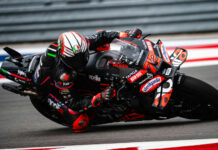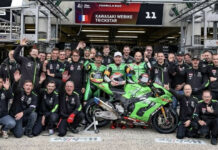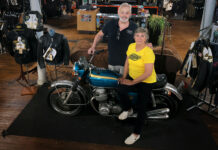FIRST PERSON/OPINION By David Swarts It’s easy to get lost in this, so I’m going to keep this as short and to the point as I can. Daytona Motorsports Group (DMG) is going about things all wrong. They are trying to reinvent something that isn’t broken, and in the process are alienating nearly all of the stakeholders — riders, team owners, manufacturers, sponsors and fans — currently involved in the sport. I was excited when I heard that DMG had purchased AMA Pro Racing. I thought that DMG’s resources, connections with television networks and experience in marketing motorsports would be exactly the shot in the arm that could help motorcycle road racing continue to grow and improve. And I was not alone, according to a poll I took of AMA stakeholders immediately after the announcement was made in Daytona earlier this year. But since that time things have gradually and with increasing speed started going downhill. DMG has proposed two new primary classes for the future of AMA Pro road racing, Daytona Superbike and LiterBike. Daytona Superbike is very close to the current Formula Xtreme class, and with little surprise as it was originally designed to be a new sprint racing class to be added to the existing MOTO-ST series. Daytona Superbike was designed so that a variety of middleweight machines with a variety of different engine configurations could be competitive racing against one another. To increase parity among different brands, engine configurations and the haves and the have-nots, the foundation of the Daytona Superbike class is a sliding horsepower-to-weight ratio (three pounds per horsepower) that can be adjusted to theoretically level things out when and if needed. While the basic concept of Daytona Superbike isn’t inherently bad, there are several flaws in its conception. First, in addition to parity, the technical rules are supposed to help keep costs low, but the class allows largely unlimited engine modifications and has no limit on torque output. Theoretically, this means an engine builder with a big imagination and a big budget could add all kinds of exotic internal parts (like a billet knife-edged crankshaft and a custom eight-speed gearbox) to create a perfectly legal engine that spins up like a two-stroke and produces a Himalayan torque curve. Unlimited modifications means unlimited budget. Making special rules to make it possible for Aprilia Tuonos, Buell 1125Rs, KTM SuperDukes and MV Agusta Brutales to compete with 600cc four-cylinder machines in Daytona Superbike sounds nice on the surface, but why is DMG making accommodations for these smaller manufacturers? Are they going to field factory teams, support riders, sponsor events, place ads and buy TV commercials like the Japanese manufacturers have been doing for years? And the last time I checked all of those manufacturers already build bikes that are eligible for AMA racing, including Buell’s rules-bending XBRR Formula Xtreme racer, but I haven’t seen any of them supporting AMA Pro road racing in any significant way. But the biggest problem I (and many fans I have spoken to) have with Daytona Superbike is that it is being billed as the premier class. The close racing in the AMA 600cc classes is great, but it is not premier class stuff. In racing, premier class means the biggest, the baddest, the most challenging platforms with the best of the best riders — the class every young racer aspires to be in. I can’t think of any racing series where the premier class is not the fastest class of racing. And in this day and age of motorcycle road racing, outside of MotoGP, the term premier class means tire-spinning, wheel-standing, flame-throwing, 210+ horsepower, 1000cc Superbikes. DMG did not originally want to include a 1000cc class, but after discussions with the four Japanese motorcycle manufacturers DMG announced it would add a class tentatively named LiterBike for 1000cc four-cylinder machines and possibly 1200cc Twins, like the Ducati 1098S and the KTM RC8 1180. Initially, DMG planned to simply adopt the complete 2009 AMA Superbike rules package, which had been developed with input by the four Japanese manufacturers over a period of quite some time. This was seen as a hugely positive step in the eyes of many AMA stakeholders, including myself, but DMG threw in one caveat. DMG asked the manufacturers to guarantee they would put somewhere between four and six quality bikes and riders on the grid or else their model would not be homologated for racing. Even though DMG representatives publicly stated all of these bikes did not have to be multi-million-dollar Ben Spies-spec GSX-R1000s or Jamie Hacking-spec ZX-10Rs, apparently some manufacturers got sticker shock when thinking about putting four to six factory bikes and riders on the grid. Yamaha’s Keith McCarty came back and asked DMG to consider making the 2009 LiterBike rules a little closer to the current Superstock rules, and DMG contacted the manufacturers again about the possibility of reverting back to Superstock rules. American Suzuki and American Honda gave no response, and Kawasaki gave an immediate favorable response, according to DMG. With half of the industry’s core supporting the Superstock-spec format and DMG’s own preference for Superstock rules, DMG made LiterBike much closer to the current Superstock class — actually closer to Canadian Superbike rules — with a 370-pound minimum weight limit and 185-horsepower maximum limit. This change alone may cause Suzuki and Honda to pull their support from AMA Pro road racing, if their published comments can be taken as legitimate and not posturing. The technical rules for LiterBike are very similar to Daytona Superbike, including dyno-enforced maximum horsepower limits and the requirement that an “approved engine control unit must be used without any modification whatsoever.” Some in the paddock do not like dyno-controlled classes because they think DMG cannot enforce the limits, and you can consider me one who is doubtful, even with the draconian penalties — fines of up to $250,000 and suspensions for at least one year — for those caught cheating. DMG plans to police these rules with technical inspections and by swapping out Engine Control Units (ECU) with standard ECUs they keep on hand, but in this age of technology if DMG thinks it can stop a manufacturer from cheating within the electronics of the motorcycle it designed and built then they are fooling themselves. So if we have to switch from true Superbikes to Superstock-spec LiterBikes what exactly is wrong with simply keeping the AMA Superstock rules as they are? Two different brands have won this year, including three teams with widely varying budgets. And I wouldn’t bet against Jamie Hacking on a factory Kawasaki ZX-10R or Ben Bostrom on Yamaha’s upcoming new YZF-R1 taking Superstock/LiterBike victories in 2009. Some say the switch from full-blown Superbikes to slower LiterBikes has to be made because the Superbikes are getting too fast for current AMA venues, and there is some validity in that argument. But instead of the horsepower limits, DMG could control the speed of the LiterBikes with its other rules, the inclusion of spec fuel and spec tires. Not many in the paddock have a problem with spec fuel. In fact, many who have to work with the toxic brews currently burned by AMA racebikes would welcome this change, which could limit, to a certain degree, how much horsepower the bikes produce and reduce costs overall. As for spec tires, not only could they limit cornering speeds, in turn adding safety, they would also add parity, allowing privateers and small teams access to the same tires used by the top teams, which is not the case right now. On the other hand, however, larger teams that get their tires for free and/or get paid for using and/or winning with certain tire brands do not like the idea of suddenly having to pay for tires. It adds a big, new bill for them. But DMG could offset those new expenses by following through with its proposal to control testing (a limited number of official tests open to all licensed riders) and to cut race weekends down from five-day adventures (set-up to tear-down) to three-day events. As for adding MOTO-ST endurance races to some, not all, AMA events, it just does not make sense. What does a three-hour endurance race add to an AMA weekend? At Road America it absolutely added complications and resentment among those in the paddock, but I’m not sure what, if anything, it added to the fan experience or spectator attendance. Unless you’re French, motorcycle endurance racing is a sport for the participants, not the spectators. One thing adding an endurance race certainly does is bring in a lot more revenue through the back gate via entry fees, license fees and crew passes. I don’t have all of the answers, and I freely admit it is an extremely difficult task to make significant improvements to AMA Pro road racing, especially in challenging economic times. It requires people who can take in the views from all sides riders, team owners, sponsors, promoters, television and spectators and come up with a workable solution. And it takes strong leadership, something the AMA Superbike series has been sorely lacking for a long time, to get all of the parties involved to buy into the plan and stick with it during the rough transition period. But leadership is one area where, in my opinion, DMG is failing miserably. The inflammatory comments and tone used in numerous media interviews by DMG principal Roger Edmondson have done more to rob his “regime” of good will, creditability and cooperation than all of the questionable class and rule changes combined. Things were already tense enough when Edmondson declared himself ruler of a dictatorship, but when he declared AMA Pro road racing would race rain or shine at nearly every venue and declared the Rider Safety Council irrelevant he crossed a line. Now I understand that an event promoter (usually the track owner/operator) needs some certainty that a race will be run. They are investing a lot of money to host their event and they don’t want to have to refund tickets to unhappy fans who were promised a race and didn’t get to see it and may or may not come back to another event. But on the other hand some of the tracks where racing in the rain is controversial, the promoters continue to put “rain or shine” guarantees on their tickets while at the same time resisting even minimal additional changes to improve rider safety. And when the track owners cry poor it only infuriates the paddock because the AMA Superbike Championship is the biggest spectator event at nearly every venue it visits and even cheap and easy changes that would have huge benefits are not always made. With his most recent comments, Edmondson has put himself firmly on the side of the event promoters/track owners and in the process alienated all of the men and women putting their lives on the line for a pittance in compensation, relative to other professional athletes. Many riders I have spoken with, off the record, either want to retire or go racing somewhere else. What will Edmondson be selling to his promoters if all of the top riders in America go racing in Europe and half of the manufacturers pull their factory and supported teams, advertising and sponsorship? It’s called a club race, and it’s been tried before under the guise of North American Sport Bike (NASB) and Formula USA, and it failed. In my humble opinion as a 10-year veteran of AMA Pro road racing circles (admittedly a childhood compared to most in the paddock), I think DMG is wasting valuable time and good will trying to reinvent AMA Pro road racing, a sport that isn’t perfect but is far from being completely broken. I feel DMG principals would see a much better return on their investment (and the sport would continue to grow) if they left what was on the racetrack alone or made only minor tweaks while running and studying the series for a couple of years and at the same time focused its time, energy, vast resources and undeniable marketing skills outside of the racetrack to bring in new sponsors, better TV and more fans.
FIRST PERSON/OPINION: Roadracing World’s David Swarts Comments On DMG’s Plans For AMA Racing
FIRST PERSON/OPINION: Roadracing World’s David Swarts Comments On DMG’s Plans For AMA Racing
© 2008, Roadracing World Publishing, Inc.






